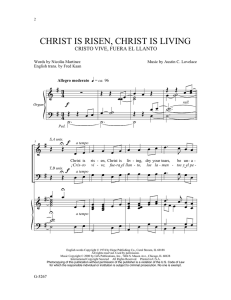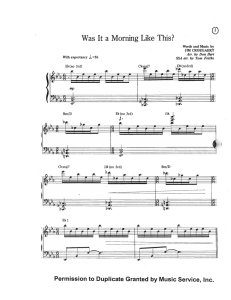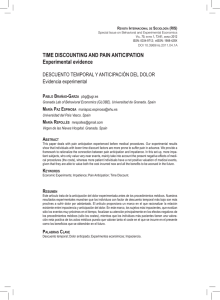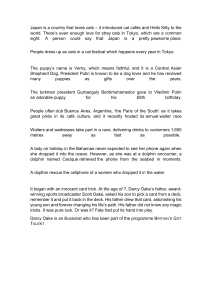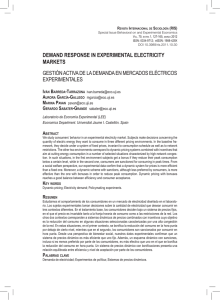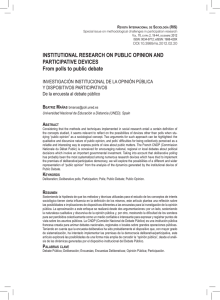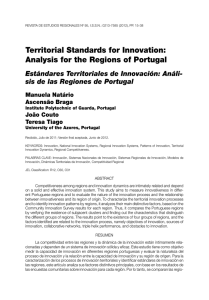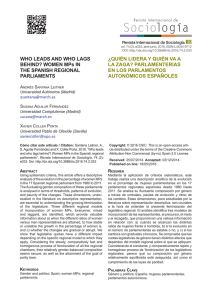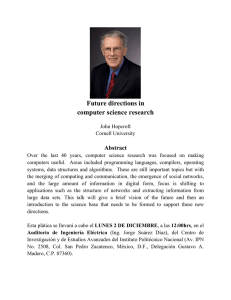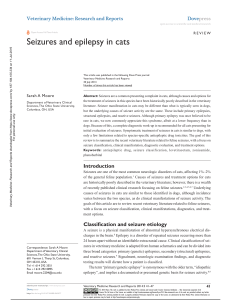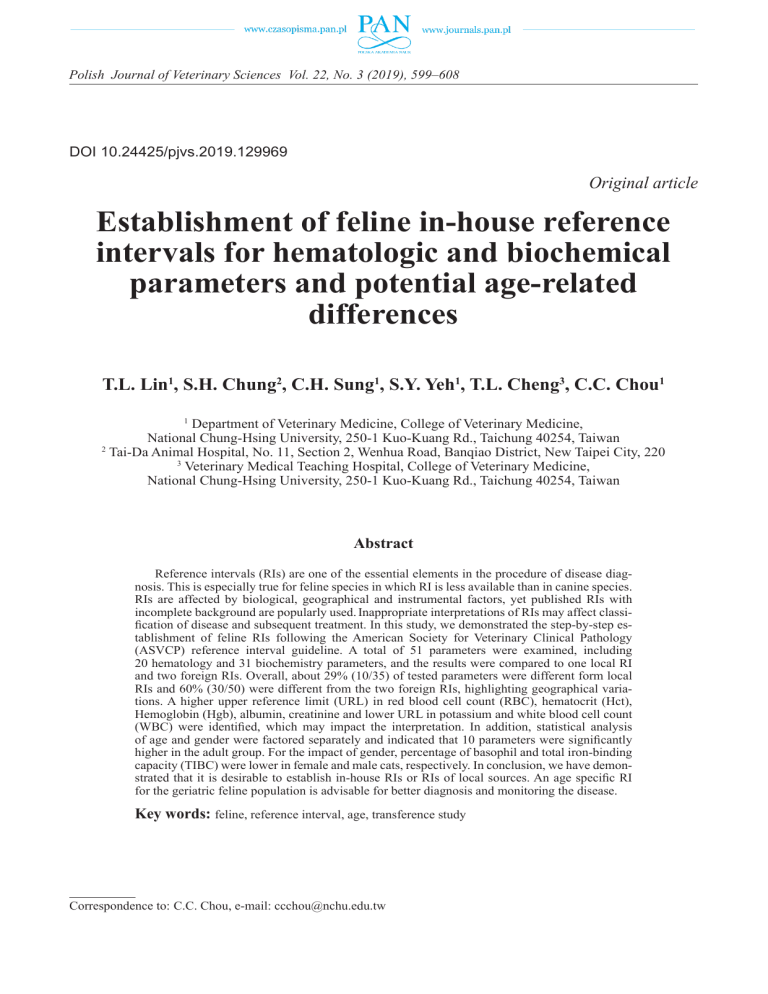
Polish Journal of Veterinary Sciences Vol. 22, No. 3 (2019), 599–608 DOI 10.24425/pjvs.2019.129969 Original article Establishment of feline in-house reference intervals for hematologic and biochemical parameters and potential age-related differences T.L. Lin1, S.H. Chung2, C.H. Sung1, S.Y. Yeh1, T.L. Cheng3, C.C. Chou1 Department of Veterinary Medicine, College of Veterinary Medicine, National Chung-Hsing University, 250-1 Kuo-Kuang Rd., Taichung 40254, Taiwan 2 Tai-Da Animal Hospital, No. 11, Section 2, Wenhua Road, Banqiao District, New Taipei City, 220 3 Veterinary Medical Teaching Hospital, College of Veterinary Medicine, National Chung-Hsing University, 250-1 Kuo-Kuang Rd., Taichung 40254, Taiwan 1 Abstract Reference intervals (RIs) are one of the essential elements in the procedure of disease diagnosis. This is especially true for feline species in which RI is less available than in canine species. RIs are affected by biological, geographical and instrumental factors, yet published RIs with incomplete background are popularly used. Inappropriate interpretations of RIs may affect classification of disease and subsequent treatment. In this study, we demonstrated the step-by-step establishment of feline RIs following the American Society for Veterinary Clinical Pathology (ASVCP) reference interval guideline. A total of 51 parameters were examined, including 20 hematology and 31 biochemistry parameters, and the results were compared to one local RI and two foreign RIs. Overall, about 29% (10/35) of tested parameters were different form local RIs and 60% (30/50) were different from the two foreign RIs, highlighting geographical variations. A higher upper reference limit (URL) in red blood cell count (RBC), hematocrit (Hct), Hemoglobin (Hgb), albumin, creatinine and lower URL in potassium and white blood cell count (WBC) were identified, which may impact the interpretation. In addition, statistical analysis of age and gender were factored separately and indicated that 10 parameters were significantly higher in the adult group. For the impact of gender, percentage of basophil and total iron-binding capacity (TIBC) were lower in female and male cats, respectively. In conclusion, we have demonstrated that it is desirable to establish in-house RIs or RIs of local sources. An age specific RI for the geriatric feline population is advisable for better diagnosis and monitoring the disease. Key words: feline, reference interval, age, transference study Correspondence to: C.C. Chou, e-mail: [email protected] 600 T.L. Lin et al. Introduction Reference intervals are used to describe the dispersion of variables in animals comprising 95% of the healthy population. Establishing RIs gives the clinical veterinarian a more objective view for evaluating the health status of patients (Geffré et al. 2009). Although it is not easy to establish in-house RIs for every clinic for various reasons, ideally every laboratory is advised to have their own RIs to better reflect the local conditions, such as biological, geographical and instrumental factors which, partly or entirely, may influence the RI range generated for disease diagnosis. Many surveys have demonstrated the biological effects of cats on RIs. For instance, Paltrinier et al. (2014) compared of the published RIs with four different cat breeds including Abyssinian, Holy Birman, Norwegian Forest and Siberian, and found that RBC, mean corpuscular volume (MCV), mean corpuscular hemoglobin concentration (MCHC), lymphocyte, platelets (PLT) and total protein were significantly different among breeds using transference study. Collectively, microcytosis in RBC and high α2-globulin concentration were found in Abyssinian cats, and higher serum creatinine, α2-globulin and glucose concentration were found in Holy Birman cats, while higher serum alkaline phosphatase (ALP) activity and calcium and phosphate concentration were found in Norwegian Forest cats. In addition, lower β2-globulin and γ-globulin concentration were recorded in Norwegian Forest and Siberian cats (Paltrinieri et al. 2014). For the effect of age, Levy et al. (2006) have found that calcium and phosphorus concentrations were higher, while albumin and total protein concentrations were lower in kittens less than 8 weeks old compared with adults (Levy et al. 2006). Beside the impact of breed and age, sex and body weight as well as living environment also showed a statistically significant effect on RIs. The instruments used for RI establishment also have confounding effect on RIs; different methodologies and parameter settings between different instruments may cause distinct results. In hematology, reticulocyte counts are most likely to be higher when using laser-based instruments, which are more sensitive for RNA detection. Impedance-based analysis may falsely identify PLT as erythrocyte, consequently the MCV and mean platelet volume (MPV) in cats can be influenced, such that the lower limit of MCV will be lower and the upper limit of MPV may be higher (Moritz et al. 2004). In biochemical parameters, a bias from 25-117% has been reported for gamma-glutamyl transferase (GGT), creatine kinase (CK) and ALP between the wet and dry methods (Flatland et al. 2014). The impact of the geographical factor has been less reported. To our knowledge, most of the veterinary clinical laboratories in Taiwan use various published or established references, which can be quite different from each other and without the background information from which the RIs were established. Since the RIs are associated with the distribution of population, breeds and analytical methods, it is hard to tell whether the published references are suitable for a given laboratory. Using inappropriate RIs in daily clinical practices may result in inappropriate diagnosis and treatment. The aim of this study was to demonstrate the use of a standard protocol in the establishment of in-house RIs suitable for a local clinical laboratory setting. The criteria for selection of healthy individuals, preanalytical performance and statistical assessment were discussed. The RIs established in this study were compared to established RIs from one local and two foreign veterinary clinical laboratories. This information should facilitate the use of in-house RIs that is a better reflection of local animal circumstances. Materials and Methods Animals and samples The experimental protocol was designed following the ASVCP reference interval guideline (Friedrichs et al. 2012). The animals were collected from the Veterinary Medical Teaching Hospital at National Chung Hsing University, Taichung, Taiwan. Blood samples were collected from clinically healthy cats (n=44; 57% female and 43% male) from March 2014 to December 2017. Cats ranging from 6 months to 14 years old were included. Before sample collection, a questionnaire was given to the owners for assessment of the health status. Questions given included genealogy, vaccination and parasite prevention record, past medical history, living environment and recent urination and defecation. In addition, auscultation, rectal temperature and palpation of the abdomen and lymph nodes were performed by an experienced veterinarian. Cats with disease history within a year or showing any sign of abnormalities in the above examination were excluded from the study. Preanalytical factors All cats were fasted for at least 8 hours and rested for at least 10 minutes before drawing blood from the jugular vein. Tubes with K2-EDTA were used for hematologic analysis; serum separation tubes were used for specific biochemistry parameters including serum iron and total iron-binding capacity (TIBC); heparin tubes were used for the remaining biochemistry parameters. 601 Establishment of feline in-house reference intervals ... Fig. 1. Statistical analysis procedure for establishing in-house reference interval. Hematologic analysis Statistical analysis Hematologic values were analyzed using an IDEXX ProCyte DxTM Hematology Analyzer (IDEXX Laboratories, Westbrook, MA, USA). The following parameters were measured: RBC, Hgb, Hct, MCV, mean corpuscular hemoglobin (MCH), MCHC, red cell distribution width (RDW), WBC, percentage and number of neutrophils, lymphocytes, monocytes, eosinophils, basophils, PLT. As the machine does not distinguish segmented and band neutrophils, a manual WBC differential counts per 200 WBCs was performed if band neutrophils were suspected by the machine. All of the data were analyzed using a Reference Value Advisor (RVA) (Microsoft Corp, Redmond, WA, USA), which is an Excel statistical software that computes reference intervals from data in the spreadsheet (Geffré et al. 2011). The Anderson-Darling test was used to access the normality for both untransformed and Box-Cox transformed data. When p>0.05, it meant the data had a Gaussian distribution, and a parametric method was then used. Otherwise, the data had a non-Gaussian distribution (when p<0.05), which was then transformed into Gaussian distribution by Box-Cox transformation. For data that still showed non-Gaussian distribution, a nonparametric method was used. Tukey’s criterion and visual inspection were used to identify any suspected outliers. The outliers’ data was not eliminated unless the respective cat was deemed unhealthy through further examination and follow up (Fig. 1). The established RIs were compared to three candidate RIs established by two foreign RIs, the “Cornell University Veterinary Hospital” (Cornell) (AHDC 2017a,b) and the “Duncan and Prasse’s Veterinary Laboratory Medicine” (Duncan) text book (Krimer et al. 2011) and one local RI from the “National Taiwan University Animal Teaching Hospital” (NTU) (unpublished data) was also compared. A transference study was used to see the difference within the above RIs. Twenty samples without outliers were randomly chosen for each parameter and validated with each of the three Biochemical analysis Aspartate aminotransferase (AST), alanine aminotransferase (ALT), ALP, CK, GGT, total bilirubin, direct bilirubin, fast glucose, lactate dehydrogenase (LDH), blood urea nitrogen (BUN), creatinine, total protein, albumin, globulin, albumin and globulin ratio (A/G ratio), calcium, phosphate, magnesium, serum iron, TIBC, total CO2 (tCO2), amylase, cholesterol, triglyceride and uric acid were analyzed using a Hitachi 717 automatic analyzer (Roche, Basel, Switzerland). The concentration of sodium, potassium and chloride were analyzed using a Biolyte 2000 electrolyte analyzer (BioCare, USA). 602 T.L. Lin et al. Fig. 2. Comparison of current (NCHU) RIs for hematologic parameters to three references: National Taiwan University Animal Teaching Hospital (NTU), Cornell Animal Hospital (Cornell), Duncan and Prasse’s Veterinary Laboratory Medicine: Clinical Pathology (Duncan). Asterisks denote significant difference from NCHU. candidate RIs. If <10% of the data (n=2) were outside the candidate RI, it was considered as having no significant difference. If >25% of the data (n=5) were outside the candidate RI, it meant that the RI showed a significant difference between 2 references. If 10-25% of the data (n=3 or n=4) were outside the candidate RI, the next 20 samples were randomly chosen from the original data and validated with candidate RIs again, using the threshold of 10% of data (n=2) outside the RI to show whether the RI in this study had a significant difference with the candidate RI (Friedrichs et al. 2012, Paltrinieri et al. 2014). To evaluate the impact of age and gender, the Mann-Whitney U test was used for non-Gaussian distribution and an independent simple T test was done for Gaussian distribution by using SPSS, Version 20.0 (IBM Corp, Armonk, NY). Two age groups, an adult (0.5-6 years old) and on elder group (≥6 years old) were compared. 603 Establishment of feline in-house reference intervals ... Table 1. Sample size, Gaussian distribution, means, medians, range, standard deviations, normality, method, RIs and 90% CI for the reference limit of hematologic parameters in 43 cats. Analytes SI n L/L 43 0.43 0.43 12 10 /L 43 10.1 10.000 g/L 43 141 140 MCV fL 43 44.1 43.70 MCHC g/L 43 326 324 MCH pg 43 14.0 14.1 RDW % 43 23.7 23.9 9 10 /L 43 7.2 Neu Percentage % 43 Lym Percentage % 43 Mon Percentage % Eos Percentage % Hct RBC count. HGB WBC count. Baso Percentage Median* Mean* Od Da Normality (P)b Mc 0 G P: 0.167; BC: 0.211 P 11.8-12.7 0 GT P: 0.049; BC: 0.069 add T 162-175 0 G P: 0.170; BC: 0.296 P 49.3-52.3 0 G P: 0.296; BC: 0.779 P 346-359 S: 1 G P: 0.176; BC: 0.176 P 11.5-12.4 15.8-16.7 S: 1 G P: 0.777; BC: 0.769 P 17.8-19.8 28-30.1 S: 3 G P: 0.156; BC: 0.238 P 1.8-3.8 11.5-13.6 S: 1 G P: 0.285; BC: 0.902 P 21.3-72.9 16.3-26.6 67.3-78.3 0 G P:0.328; BC:0.405 P 19.4-71.9 16-23.4 64.7-78.8 0 G P:0.031; BC:0.108 P 5.0 0.9-4.8 0.8-1.1 3.9-5.8 S: 3 GT P:0.004; BC:0.687 add T 17.5 3.1-14.7 2.8-3.6 12.7-16.7 S: 1 GT P:0.022; BC:0.602 add T RI LRL 90% CI SD* Min* Max* 0.05 0.35 0.53 1.3 7.1 12.1 7.1-12.3 6.3-7.8 14.2 111 162 111-169 105-117 3.5 35.6 50.9 36.5-50.8 35.1-38 14.2 281 346 295-353 289-301 1.1 12.1 16.8 12-16.3 2.5 18.0 31.2 18.8-29 7.7 2.4 3.4 14.4 2.8-12.6 48.4 47.1 12.6 16.3 70.6 39.0 42.5 13.0 18.2 71.9 43 2.0 2.2 0.9 0.7 43 6.5 7.4 3.0 2.9 URL 90% CI 0.323-0.543 0.30-0.345 0.519-0.566 % 43 0.5 0.7 0.5 0.0 2.1 0-2.1 0-0.1 1.9-2.1 S: 1 NG P:0.001 NP Neutrophil 109/L 43 3.3 3.6 1.5 0.7 6.9 0.6-6.8 0-1.2 6-7.3 0 G P: 0.082; BC: 0.194 P Lymphocyte 9 10 /L 43 2.9 3.2 1.3 1.1 7.9 1.5-5.9 0-1.1 5.3-6.5 S: 1 G P: 0.241; BC: 0.907 P Monocyte 109/L 43 0.1 0.2 0.1 0.0 0.6 0-0.6 0 0.3-0.6 O: 1; S: 1 Eosinophil 109/L 43 0.5 0.6 0.4 0.2 2.4 0.2-1.6 0.2-0.2 1.2-2.4 O: 1; S: 1 GT P:0; BC: 0.899 add T Basophil 109/L 43 0.0 0.0 0.0 0.0 0.2 0-0.18 0-0.01 0.14-0.18 S: 1 NG P:0.001; BC:0.002 NP Platelet count. 9 10 /L 43 220 220 71.0 60 373 S: 2 G P: 0.449; BC: 0.504 P Reticulocyte count 109/L 43 26.6 28.8 17.8 5.1 78.6 S: 1 GT P: 0.024; BC: 0.265 add T 74.7-364.6 46.4-104.5 333.2-394.6 4.4-57.0 3.2-6.7 61.7-88.6 NG P<0.0001; BC: 0.001 NP * Calculated using untransformed data a Gaussian distribution: G, Gaussian; NG, non-Gaussian; GT, Gaussian after transformation. b Normality testing was assessed using the Aderson-Darling test on untransformed (P) and Cox-Box transformed values. c Method: P, parametric; NP, nonparametric; R, robust; add T, transformed, if data was transformed to Gaussian prior to applying parametric or robust methods. d Outlier: S, Suspected outliers; O, outliers. LRL, lower reference limit 90% CI; URL, upper reference limit 90% CI; O, Outliers; D, Gaussian distribution; M, Method; SI, SI units. Results Reference population The age of the cats in this study ranged from 6 months to 14 years old with a median of 4.6 years old. Seventy-two percent of the cats were between 1 and 6 years old, 2.3% were under 1 year old and 25.6% were over 6 years old. The main breeds of the cats were mixed breed (63.6%), American Shorthair (11.4%), British Shorthair (6.8%) and Persian (9.1%). Other breeds (9.1%) included Chinchilla, Exotic Shorthair, Himalayan and Scottish Fold. Hematologic parameters Data distributions and statistical results for hematologic analysis are listed in Table 1, which includes information regarding sample sizes, the median number, means, ranges, standard deviation, normality, statistical method, RIs, 90% CI for the reference limit and the number of outliers. One sample was excluded due to severe sample coagulation. Sixty percent (12/20) of the hematologic parameters showed Gaussian distribution, while 25% (5/20) of the parameters showed Gaussian distribution after Box-Cox transformation. Hematologic parameters with significant difference to other candidate RIs are shown in Fig. 2. Sixty-two percent (8/13) of the tested parameters showed significant difference from the local RIs. Hct, MCV, Hgb and RDW were higher and MCHC, WBC, neutrophil and PLT were lower than those in NTU. Sixty-five percent (13/20) of the parameters were different from the two foreign RIs; specifically, RBC, Hct, Hgb, RDW and the percentage of neutrophils, lymphocytes, eosinophils and basophils were higher, while MCV, MCHC, reticulocyte, neutrophil and PLT countwere lower than the RIs in Cornell and Duncan. Age showed a significant effect on RBC, Hct, Hgb, RDW, number of basophil, number of lymphocyte and the reticulocyte count. All of these parameters were significantly higher in the adult group (Table 3). The percentage of basophils was significantly different between genders. (Table 4 and 5). 604 T.L. Lin et al. Table 2. Sample size, Gaussian distribution, means, medians, range, standard deviations, normality, method, RIs and 90% CI for the reference limit of biochemistry parameters in 44 cats. Analytes SI N Median* Mean* AST U/L 44 23.5 ALT U/L 44 54.0 ALP U/L 44 34.0 GGT U/L 43 0.0 CK U/L 41 156.0 Fast glucose mmol/L 44 6.30 BUN mmol/L 44 9.3 Creatinine SD* Min* Max* RI LRL URL Od Da 60.0 13-62 144.0 29-142 13-62 26.0 11.1 13.0 63.8 28.5 32.0 12-14 47-84 0 GT P<0.0001; BC: 0.244 add T 26-32 115-169 0 GT P<0.0001; BC: 0.119 add T 37.3 12.0 12.0 70.0 8-18 57-67 S: 1 G P: 0.114; BC: 0.598 0.3 0.5 0.0 2.0 0-2 - - 0 185.1 102.1 70 511 70-558 61-83 388-856 S: 2 GT P<0.0001; BC: 0.507 add T 6.49 1.1 4.5 9.3 4.3-8.7 3.9-4.7 8.2-9.1 0 G P: 0.414; BC: 0.993 P 9.5 1.6 6.4 13.2 6.3-12.7 5.7-7.0 12.0-13.3 0 G P: 0.213; BC: 0.278 P P Mc P NG P<0.0001; BC <0.0001 NP μmol/L 44 159.1 164.3 29.1 123.8 238.7 0 G P: 0.113; BC 0.418 LDH U/L 42 101.5 109.2 50.4 31.0 287.0 40-246 34-50 202-295 O: 1; S: 2 GT P: 0.002; BC: 0.217 add T Total protein g/L 44 73 74 5.1 62 83 63.5-84.5 61.5-65.7 82.2-86.6 0 G P: 0.312; BC: 0.259 P Albumin g/L 44 38 38.3 3.2 33 46 31.8-44.8 30.6-33.1 43.4-46.1 0 G P: 0.052; BC: 0.225 P Globulin g/L 44 36 35.7 4.9 23 48 25.7-45.6 23.8-27.8 43.5-47.6 0 G P: 0.814; BC: 0.841 P 44 1.1 1.1 0.2 0.7 1.7 0.7-1.5 0.6-0.8 1.4-1.6 S: 2 G P: 0.068; BC: 0.145 P Calcium mmol/L 44 2.4 2.4 0.2 2.2 2.8 2.1-2.8 2-2.2 2.7-2.8 0 G P: 0.067; BC: 0.694 P Phosphate mmol/L 44 1.2 1.2 0.2 0.8 1.9 0.7-1.7 0.6-0.8 1.6-1.8 S: 1 G P: 0.440; BC: 0.901 P Magnesium mmol/L 43 1.0 1.1 0.4 0.7 2.7 0.7-2.0 0.65-0.74 1.6-2.78 S: 4 GT P<0.0001; BC: 0.488 add T Serum iron μmol/L 42 20.0 20.9 4.8 13.6 34.2 11-30.8 9.1-13.1 28.6-32.8 S: 1 G P: 0.074; BC: 0.981 P TIBC Transferrin saturation Sodium μmol/L 38 81.6 81.2 15.8 52.6 117.6 48.7-113.6 42-55.8 106.2-120.8 0 G P: 0.706; BC: 0.707 P % 38 25.0 26.4 8.5 16.0 57.0 - - - - - P: 0.004; BC: 0.008 - mmol/L 41 154.0 153.4 1.9 150 157 150-157 150-151 156-157 0 NG P: 0.045; BC: 0.028 NP Potassium mmol/L 41 3.7 3.8 0.3 3.3 4.3 3.3-4.3 3.3-3.4 4.2-4.3 0 NG P: 0.018; BC: 0.044 NP Chloride mmol/L 41 121.0 120.3 3.7 110.0 126.0 113-129 111-114 126-129 S: 1 G P: 0.077; BC: 0.077 P tCO2 mmol/L 44 21.8 21.1 3.4 11.2 28.6 14-28 13-16 27-29 S: 1 G P: 0.634; BC: 0.847 P Anion Gap mmol/L 41 14.40 15.40 5.00 6.3 27.4 5-26 3-7 23-28 0 G P: 0.106; BC: 0.593 P 41 315.20 314.40 4.00 306.6 322.4 306-323 305-308 321-324 0 G P: 0.544; BC: 0.678 P 42 1201.0 1296.0 595.0 436.0 2656 432-2827 362-552 2379-3297 0 GT P: 0.026; BC: 0.647 add T 2.3-6.5 1.9-2.8 6.1-6.9 0 G P: 0.698; BC: 0.709 1.34-1.62 S: 1 G P: 0.072; BC: 0.070 P 3.2-3.4 0 NG P<0.000; BC<0.0001 NP A/G Osmolality Amylase U/L Cholesterol mmol/L 43 4.4 4.4 1.0 2.4 6.6 Triglyceride mmol/L 43 0.81 0.82 0.33 0.18 2.02 Total bilirubin μmol/L 44 1.7 1.4 1.0 0 3.42 Direct bilirubin μmol/L 41 0.85 0.85 0.86 0 Uric acid μmol/L 43 5.9 4.8 5.1 0 105.1-223.6 93.6-117.1 210.1-235.7 Normality (P)b 0.15-1.49 0.01-0.28 P 0-3.42 0-0 1.71 0-1.7 0-0 1.7-1.7 0 NG P<0.0001; BC<0.0001 NP 17.9 0-17.3 0-0 11.9-17.9 0 NG P<0.0001; BC<0.0001 NP - , not reported; * Calculated using untransformed data a Gaussian distribution: G, Gaussian; NG, non-Gaussian; GT, Gaussian after transformation. b Normality testing was assessed using the Aderson-Darling test on untransformed (P) and Box-Cox transformed values. BC: P of Box-Cox c Method: P, parametric; NP, nonparametric; R, robust; add T, transformed, if data was transformed to Gaussian prior to applying parametric or robust methods. d Outliers: S, Suspected outliers; O, outliers. Biochemistry parameters Data distributions and statistical results for biochemistry analysis are shown in Table 2, data presented included the sample sizes, median, means, ranges and standard deviation, normality, statistical method, RIs and 90% CI for the reference limit and the number of outliers. Fifty-eight percent (18/31) of the data showed Gaussian distribution and 19% (6/31) showed Gaussian distribution after Box-Cox transformation. The RI of transferrin saturation could not be established due to a failure to transform into normal distribution after Box-Cox transformation and the sample size in this category was less than 40, which excluded the use of nonparametric calculation. The biochemistry parameters with significant difference to other candidate RIs are shown in Fig. 3. Only about 9% (2/22) of the tested parameters showed a significant difference from the local RIs, namely the albumin and amylase were significantly higher. Fifty-seven percent (17/30) were different from the foreign RIs, including ALT, ALP, fast glucose, creatinine, total protein, albumin, AG ratio, magnesium, TIBC, osmolality and cholesterol which were all higher Establishment of feline in-house reference intervals ... 605 Fig. 3. Comparison of RIs for biochemistry parameters in three references: NTU, Cornell and Duncan. Asterisks denote significant difference from NCHU. 606 T.L. Lin et al. Table 3. Parameters showing statistically significant differences with age. Adult (<6 yr) Elder (≥6 yr) Mean±SD Mean±SD 7.1-12.3 10.29± 1.16 (n=30) 8.96± 1.03 (n=12) 0.005* Hct (L/L) 0.323-0.543 0.445± 0.05 (n=30) 0.400± 0.04 (n=12) 0.009 Hgb (g/L) 111-169 143.1± 14.1 (n=30) 129.8± 12.5 (n=12) 0.007 RDW (%) 18.8-29 24.56± 2.28 (n=30) 22.14± 2.13 (n=12) 0.003 Reticulocyte count (109/L) 4.4-57.0 32.65± 18.97 (n=30) 19.42± 11.25 (n=12) 0.024* Lymphocyte count (109/L) 1.5-5.9 3.53± 1.37 (n=30) 2.57± 0.94 (n=12) 0.033 Basophil count (109/L) 0-0.18 0.066± 0.044 (n=30) 0.026± 0.022 (n=12) 0.002* 0-2 0.43± 0.57 (n=31) 0.00± 0.00 (n=12) 0.045* Albumin (g/L) 32-45 39.2± 3.2 (n=31) 36.1± 1.9 (n=12) 0.003 Calcium (mmol/L) 2.1-2.8 2.47± 0.17 (n=31) 2.32± 0.53 (n=12) <0.001 Cholesterol (mmol/L) 2.3-6.5 4.20± 1.01 (n=31) 4.93± 0.9 (n=12) 0.036 Parameters RBC (1012/L) GGT (U/L) RIs p value Asterisks denote use of the Mann-Whitney U method. Table 4. Parameters showing statistically significant differences in relation to gender. Parameters Percentage of basophils TIBC (μmol/L) Male Female Mean±SD Mean±SD 0-2.1 0.84± 0.67 (n=19) 0.44± 0.63 (n=24) 0.028* 48.7-113.6 74.61± 13.94 (n=17) 86.56± 15.5 (n=21) 0.018 RIs p value Asterisks denote use of the Mann-Whitney U test method. Table 5. Presumed value in discussion and the RIs in this study (NCHU) and Cornell. Presumed values NCHU Cornell BUN (mmol/L) Parameters 22 6.4-12.5 6.1-12.5 Creatinine (μmol/L) 215 106.1-221 70.7-185.6 Sodium (mmol/L) 155 150-157 149-158 Potassium (mmol/L) 5.2 3.3-4.3 3.8-5.5 Chloride (mmol/L) 120 113-129 111-124 Albumin (g/L) 44 32-45 32-43 RBC (10 /L) 11.5 7.1-12.3 6.9-10.1 Hct (L/L) 0.5 0.323-0.543 0.31-0.48 Hgb (g/L) 160 111-169 109-157 WBC count (109/L) 15 2.8-12.6 5.1-16.2 Neutrophil (10 /L)) 9 0.6-6.8 2.3-11.6 12 9 Establishment of feline in-house reference intervals ... and the potassium was lower than the RIs from Cornell and Duncan. The reference range of LDH, tCO2, triglyceride, anion gap and amylase showed wider RIs than those in the Cornell or Duncan. In the biochemistry test, TIBC was significantly higher in the female group. GGT, albumin and calcium were significantly higher in the group of adult cats, and cholesterol concentration was higher in the older group (Table 4 and 5). Discussion To the author’s knowledge, this is the first study to compare established RIs to in-house RIs in felines in Taiwan with 20 hematology and 31 biochemistry parameters. One of the primary objectives of this study was to show the step by step establishment of in-house RIs in a clinical setting. RIs are the most important and basic laboratory data in veterinary clinics on which most of the diagnostic decision is based. Since it is believed that RIs are affected by multiple factors (biological, geographical and instrumental), the concept of in-house RIs should be practiced not only in teaching hospitals but also in regional veterinary clinics. According to the ASVCP guideline, RIs should be measured in a well characterized population. Age, sex, reproductive status, breed nutrition status and diet should all be taken into consideration. In our study, we designed a proper questionnaire to record all the biological data and the disease history of selected animals and the health status was checked by physical examination by an experienced veterinarian, followed by a visual check of the laboratory data and later confirmation of the animal status with the owners. In addition, sampling should be collected across the seasons for a better representation of analytic concentration (Friedrichs et al. 2012). In our study, feline samples were collected from March, 2014 to December, 2017, which covered the whole weather range in Taiwan. In terms of the biological and geographical variations, the hematology and biochemistry RIs in our study showed a closer similarity to those reported by the NTU than to the Cornell and Duncan. Some of the difference in RIs found in this study carried specific clinical importance. For instance, potassium plays an important role in maintaining the resting membrane potential of cells, especially for muscles and nerves. Abnormalities in serum potassium concentration causing cardiac abnormalities in ECG and muscle weakness could be life-threatening and may develop into metabolic alkalosis or acidosis (Schaer 1999). The RIs for serum potassium concentration in our study were much narrower and lower than local and foreign RIs. By directly using the established RIs, hyperkale- 607 mia could be overlooked and opportunity for detecting abnormality and giving appropriate treatment could be missed. RBC, Hct and Hgb were used to measure the amount of erythrocyte in blood vessels. An increase of Hct and RBC can be relative or absolute. For absolute increase, the primary reason is bone marrow disorder or neoplasia, and the relative increase may be caused by losing intravascular water (Harvey 2012). In our study, RBC, Hgb and especially Hct were significantly higher than both local and foreign RIs, and with the combination of URL in serum albumin concentration, the patient might be misdiagnosed as suffering from dehydration by using the established RIs. According to the above situation, direction of treatment and diagnosis could be totally different. For instance, a patient with clinical symptoms of oligourea, poor spirit and appetite, the presumed values of examples and the compared RIs are shown in Table 5. By using the Cornell RI, the laboratory results showed high levels in primary renal panel parameters. With the combination of normal value in serum electrolyte and leukogram and elevation of RBC, Hct, and albumin, the primary interpretation of the laboratory examination may be prerenal azotemia caused by dehydration. However, using the established RIs in this study though, the patient also showed high BUN values but the creatinine level was below the URL. RBC, Hct and albumin were within RIs, but the patient would show inflammatory leukogram with neutrophilia. Hyperkalemia with the clinical sign of oligouria, in addition to the above interpretation, may indicate partial loss of glomerular filtration or loss of electrolyte balance from kidney function. Creatinine level was within the URL, but creatinine would only show abnormal value when more than 75% of the renal parenchymal cell function was lost. Thus, acute kidney injury in grade II and inflammation may be suspected (Ross et al. 2011). This example highlights the possibility of a different interpretation in tentative diagnosis. Therefore, it is desirable to build our own RIs than just referring to published RIs mostly form foreign resources. A definite diagnosis should be confirmed by other supporting diagnosis data such as ultrasound and urinalysis. Aging is a natural biological progression with physiologic changes that may cause alteration in laboratory value (Bellows et al., 2016). In our study, the number for older cats (≥6 years old) was not enough for partitioning (minimum of 40 individuals within each subclass), so an independent simple T test and Mann-Whitney U test was used to measure the effect of age on laboratory values showing Gaussian distribution and non-Gaussian distribution, respectively. The result suggested that RBC, Hct and Hgb were 608 T.L. Lin et al. significantly lower in the older group. This observation was similar to the older feline RIs established by Iams Company Pet Health and Nutrition Center (Bellows et al. 2016) which was also found for humans and dogs and is known as “anemia of the elderly” (Radakovich et al. 2017). Lymphocyte count was also lower in the older group. This phenomenon was similar to previous studies in which it was seen as a normal process of immunosenescence (Desai et al. 2010, Bellows et al. 2016). The degradation of the physiological function in old cats may not be disease related but might be interpreted as chronic kidney disease or other metabolic disease (Sparkes et al. 2016). Therefore, establishing older feline RIs is critical for disease detection and monitoring of disease progression. More studies are required to further justify the use of an age-specific RI in elderly feline. To sum up, 51 parameters were tested and compared in the current study. Despite the data indicating closer similarity to local RIs (NTU) than to the foreign RIs (Cornell, Duncan), parameters showing significant differences from local RI still exist that may impact regular diagnostic interpretation, proving that it is desirable to establish in-house RIs for our own veterinarian clinics, especially for a feline population in which reliable RIs are less available. In addition, age-specific RIs for felines warrant further investigation. We have demonstrated the step by step establishment of own in-house RIs, and this should facilitate the ability of veterinary clinics to establish regional RIs that will aid in better diagnostic decision. References AHDC, New York State Veterinary Diagnostic Laboratory Animal Health Diagnostic Center (2017a) Cornell University College of Veterinary Medicine New York State Veterinary Diagnostic Laboratory Animal Health Diagnostic Center: Chemistry (Cobas) Reference Intervals, NY. https://ahdc.vet.cornell.edu/sects/clinpath/reference/ /chem.cfm [accessed 12.01.2017]. AHDC, New York State Veterinary Diagnostic Laboratory Animal Health Diagnostic Center (2017b) Cornell University College of Veterinary Medicine New York State Veterinary Diagnostic Laboratory Animal Health Diagnostic Center: Hematology Reference Intervals for Advia 2120, NY. https://ahdc.vet.cornell.edu/sects/clinpath/ /reference/hema.cfm [accessed 12.01.2017]. Bellows J, Center S, Daristotle L, Estrada AH, Flickinger EA, Horwitz DF, Lascelles BD, Lepine A, Perea S, Scherk M, Shoveller AK (2016) Aging in cats: common physical and functional changes. J Feline Med Surg 18: 533-550. Bellows J, Center S, Daristotle L, Estrada AH, Flickinger EA., Horwitz DF, Lascelles BD, Lepine A, Perea S, Scherk M, Shoveller AK (2016) Evaluating aging in cats: how to determine what is healthy and what is disease. J Feline Med Surg 18: 551-570. Desai A, Grolleau-Julius A, Yung R (2010) Leukocyte function in the aging immune system. J Leukoc Biol 87: 1001-1009. Flatland B, Breickner LC, Fry MM (2014) Analytical performance of a dry chemistry analyzer designed for in-clinic use. Vet Clin Pathol 43: 206-217. Friedrichs KR, Harr KE, Freeman KP, Szladovits B, Walton RM, Barnhart KF, Blanco-Chavez J (2012) ASVCP reference interval guidelines: determination of de novo reference intervals in veterinary species and other related topics. Vet Clin Pathol 41: 441-453. Geffré A, Concordet D, Braun JP, Trumel C (2011) Reference value advisor: a new freeware set of macroinstructions to calculate reference intervals with Microsoft Excel. Vet Clin Pathol 40: 107-112. Geffré A, Friedrichs K, Harr K, Concordet D, Trumel C, Braun, JP (2009) Reference values: a review. Vet Clin Pathol 38: 288-298. Harvey JW (2012) Evaluation of erythrocytes. In: Harvey JW (ed) Veterinary hematology: a diagnostic guide and color atlas. Elsevier Health Sciences, Elsevier, China, pp 90-92. Krimer PM (2011) Generating and interpreting test results: test validity, quality control, reference values and basic epidemiology. In: Latimer KS (ed) Duncan and Prasse’s veterinary laboratory medicine: clinical pathology. 5th ed., Wiley-Blackwell, pp 372-375. Levy JK, Crawford PC, Werner LL (2006) Effect of age on reference intervals of serum biochemical values in kittens. J Am Vet Med Assoc 228: 1033-1037. Moritz A, Fickenscher Y, Meyer K, Failing K, Weiss DJ (2004) Canine and feline hematology reference values for the ADVIA 120 hematology system. Vet Clin Pathol 33: 32-38. Paltrinieri S, Ibba F, Rossi G (2014) Haematological and biochemical reference intervals of four feline breeds. J Feline Med Surg 16: 125-136. Radakovich LB, Pannone SC, Truelove MP, Olver CS, Santangelo KS (2017) Hematology and biochemistry of aging-evidence of “anemia of the elderly” in old dogs. Vet Clin Pathol 46: 34-45. Ross L (2011) Acute kidney injury in dogs and cats. Vet Clin North Am Small Anim Pract 41: 1-14. Schaer M (1999) Disorders of serum potassium, sodium, magnesium and chloride. J Vet Emerg Crit Care 9: 209-217. Sparkes AH, Caney S, Chalhoub S, Elliott J, Finch N, Gajanayake I, Langston C, Lefebvre HP, White J, Quimby J (2016) ISFM consensus guidelines on the diagnosis and management of feline chronic kidney disease. J Feline Med Surg 18: 219-239.
